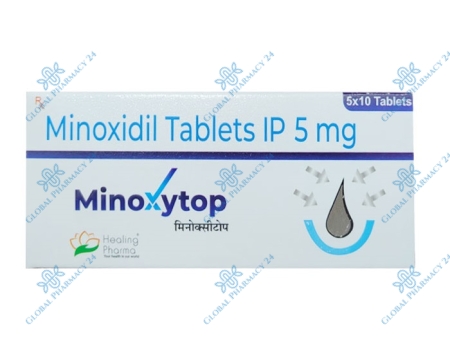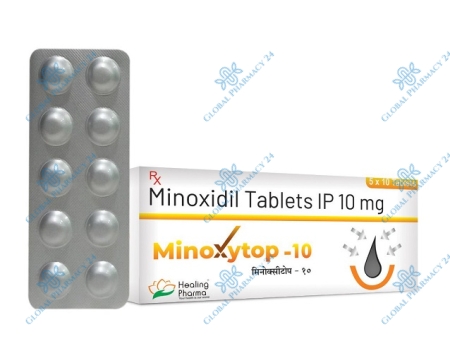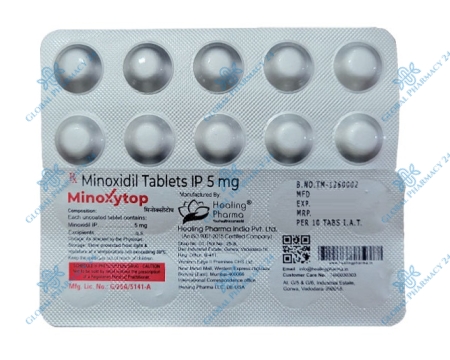| Characteristic | Detail |
|---|---|
| Active Ingredient | Minoxidil |
| Form | Tablet |
| Dosage | Typically 2.5mg to 10mg per day |
| Duration of Effect | Continues with ongoing use |
| Primary Use | Treatment of high blood pressure and hair regrowth |
Understanding Minoxidil Tablets
Minoxidil tablets are an oral medication primarily used to treat high blood pressure. They work by dilating blood vessels, which allows blood to flow more easily and reduces the workload on the heart. Apart from its vascular effects, Minoxidil has a unique side effect of promoting hair growth, leading to its use in treating certain types of alopecia (hair loss). This dual functionality makes Minoxidil tablets a subject of interest for both cardiovascular and dermatological applications.
Originally developed as an antihypertensive medication, the discovery of Minoxidil's hair regrowth potential has expanded its use. Today, it is prescribed not only to manage blood pressure but also as an off-label treatment for hair loss. Its effectiveness in stimulating hair growth has been documented in various studies, highlighting its role in the treatment of androgenetic alopecia among other conditions.
Differences between Oral and Topical Medications
Minoxidil is available in both oral and topical forms, each serving different primary purposes. Oral Minoxidil is mainly prescribed for hypertension and has the systemic effect of lowering blood pressure throughout the body. On the other hand, topical Minoxidil, commonly found in solutions or foam, is applied directly to the scalp to stimulate hair growth locally without significantly affecting blood pressure. This localized application reduces systemic side effects and focuses the drug's action on hair regrowth.
While both forms can promote hair growth, their applications and side effect profiles differ significantly. Oral Minoxidil may lead to more systemic side effects, such as an increase in heart rate or fluid retention, due to its widespread action in the body. Topical Minoxidil, though generally safer and with fewer systemic effects, can still cause local irritation or allergic reactions at the site of application. Choosing between the two forms depends on the individual's health status, treatment goals, and tolerance for potential side effects.
The Effects of Minoxidil Tablets
Minoxidil tablets exert their primary effect by relaxing blood vessels, leading to lowered blood pressure. The hair regrowth effect, while a secondary outcome, has garnered significant attention. This occurs through the prolongation of the hair follicle growth phase (anagen), which results in thicker, longer hair strands. Additionally, Minoxidil may help in reviving dormant hair follicles, contributing to an increase in hair density over time with consistent use.
The effectiveness of Minoxidil tablets in promoting hair regrowth varies among individuals, with some experiencing significant improvements while others may see minimal effects. Factors influencing responsiveness include the duration and extent of hair loss, age, and the specific cause of alopecia. It's important to have realistic expectations and understand that results may take several months to become noticeable.
Precautions and Contraindications
Individuals Who Should Avoid Minoxidil Tablets
Not everyone is a suitable candidate for Minoxidil tablet therapy. Individuals with certain conditions, such as pregnant or nursing women, should avoid its use due to the potential risks to the fetus or infant. People with severe renal (kidney) impairment, pheochromocytoma, or those allergic to any component of the drug should also refrain from using Minoxidil tablets. A healthcare provider can offer guidance on whether Minoxidil is appropriate for an individual's specific health profile.
Medications with Contraindications
Combining Minoxidil tablets with other medications can sometimes lead to adverse interactions. Particularly, drugs that also lower blood pressure, such as beta-blockers or diuretics, can potentiate the hypotensive effects of Minoxidil, leading to excessive lowering of blood pressure. It's crucial to inform healthcare providers about all medications being taken to avoid harmful interactions.
Medications with Cautionary Notes
When used alongside certain medications, Minoxidil tablets require careful monitoring. This includes drugs like nonsteroidal anti-inflammatory drugs (NSAIDs), which can reduce the effectiveness of Minoxidil in lowering blood pressure. Close supervision by a healthcare professional is necessary to adjust dosages accordingly and ensure the safe use of Minoxidil in combination with other medications.
Potential Side Effects
Initial Hair Shedding
An initial increase in hair shedding may occur when starting Minoxidil tablet therapy. This phenomenon is typically temporary and reflects the transition of hair follicles from a resting phase to an active growth phase. Patients are advised to continue the medication as the shedding usually subsides, leading to new hair growth.
Excessive Hair Growth
Excessive hair growth, known as hypertrichosis, can occur in areas other than the scalp, such as the face and body. This side effect is more common with oral Minoxidil due to its systemic action. Adjusting the dosage or switching to a topical formulation may help mitigate this effect.
Proper Usage of Minoxidil Tablets
For optimal results, Minoxidil tablets should be taken as prescribed by a healthcare provider. The dosage may vary depending on the individual's response to treatment and the condition being treated. Consistency is key, as irregular use can diminish the effectiveness of the medication. It's also important to monitor blood pressure regularly, as significant changes may require dosage adjustments.
Patient education on the proper use of Minoxidil is crucial to minimize side effects and enhance the drug's efficacy. This includes understanding the potential for initial hair shedding and recognizing signs of excessive hair growth that may necessitate consultation with a healthcare provider.
Prescription and Pricing Information
Minoxidil tablets are available by prescription in the United States. The cost can vary based on the dosage, quantity, and pharmacy. Insurance coverage for Minoxidil is inconsistent, as its use for hair loss is often considered cosmetic. However, when prescribed for hypertension, insurance plans may cover part or all of the cost. It's advisable to check with insurance providers for specific coverage details and explore generic options to reduce expenses.
Obtaining a prescription requires a consultation with a healthcare provider, who will evaluate the individual's health status and determine the appropriateness of Minoxidil as a treatment option. This process ensures that the medication is used safely and effectively, with monitoring for any potential side effects or interactions with other drugs.
Pros and Cons of Minoxidil Tablets
- Pros:
- Effective in lowering high blood pressure.
- Can stimulate hair regrowth in individuals with certain types of alopecia.
- Oral form offers a systemic treatment option for those who may not respond to topical treatments.
- Available in generic form, which can be more cost-effective.
- Cons:
- Potential for systemic side effects, such as water retention and increased heart rate.
- May cause unwanted hair growth in areas other than the scalp.
- Initial hair shedding phase can be discouraging for users.
- Requires ongoing treatment for continued effect, which can lead to long-term costs.
Understanding the full characteristics, usage, and effects of Minoxidil tablets is crucial for individuals considering this medication for hypertension or hair loss. Consulting with a healthcare provider is essential to determine the suitability of Minoxidil and to navigate its benefits and potential drawbacks effectively.
FAQs Minoxidil Tablets
What are Minoxidil Tablets used for?
Minoxidil Tablets are primarily used to treat high blood pressure (hypertension). However, they are also sometimes prescribed off-label to promote hair growth in individuals experiencing hair loss or male pattern baldness.
How do Minoxidil Tablets work for hair loss?
Minoxidil Tablets work by widening blood vessels, which increases blood flow to certain areas of the body, including the scalp. This increased blood flow can stimulate hair follicles, leading to improved hair growth.
What are the potential side effects of Minoxidil Tablets?
Common side effects of Minoxidil Tablets may include dizziness, lightheadedness, increased heart rate, and swelling of the hands or feet. Serious side effects are rare but may include chest pain, difficulty breathing, and sudden weight gain. It's important to consult with a healthcare professional before starting Minoxidil Tablets to discuss potential risks and benefits.
How long does it take to see results from using Minoxidil Tablets for hair loss?
Results from using Minoxidil Tablets for hair loss can vary from person to person. Some individuals may start to see improvements in hair growth within a few months of consistent use, while others may take longer. It's important to continue using Minoxidil Tablets as directed by your healthcare provider to maximize the potential for hair regrowth.























